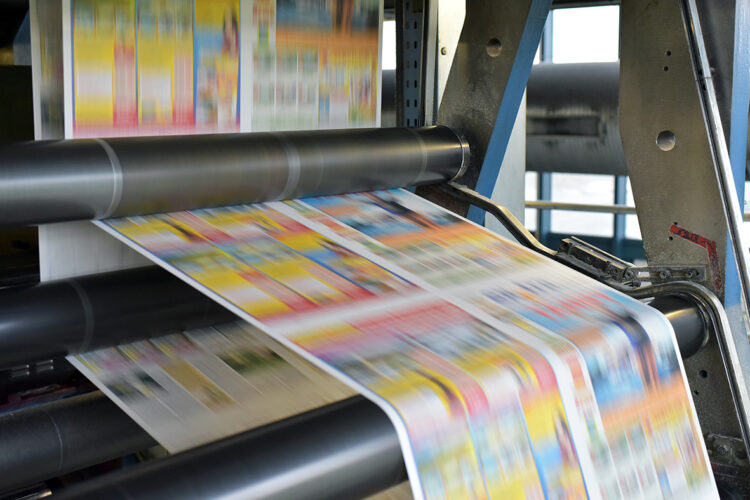Reports of printed newspapers' death are greatly exaggerated… for now

Opinion
Could a longer transformation period to prepare for full digital, a move to ‘artisan’ and a concerted marketing effort shift the timeline?
In an InPublishing interview to mark his retirement from journalism after 20 years editing The Guardian, Alan Rusbridger was asked about the future of print, in particular whether there would still be a print edition of the publication in 10 years.
He replied that sales of most nationals were declining at between 7% and 10% a year: “Ten years of 7-10% a year is quite scary.”
Rusbridger said that eventually a computer in the basement would warn that it was no longer viable to print newspapers.
“Instinct tells me the future is going to be digital, so we had better understand and be ready for that. Overwhelmingly, the cash comes from paper at the moment, so we would be crazy not to do paper” was Rusbridger’s take at the time.
Paper survives
In fact, less than a year after that interview, The Independent became the first national to go digital only.
It is perhaps remarkable that more than eight years later, The Independent is still an outlier and none of the other nationals has followed suit, despite the downward trends.
What does Rusbridger think now, after he returned to journalism as editor of Prospect — print and online — following a stint in academia?
In an interview this month in InPublishing, Rusbridger said: “The dailies will go first (into digital only), followed by the Sundays. And I don’t know about magazines.”
The former Guardian editor was less sure about the timing and admitted it was only his gut feeling. As for magazines — isn’t Private Eye flourishing as a print-only fortnightly?
“Condé Nast might tell a different story,” Rusbridger replied.
Digital an eventuality
Earlier this year, Geordie Greig was much less uncertain in another interview. Dropping print, he believes, had been great for The Independent and the publication now has around 200 journalists and claims 10bn views a year, with profits in “single-digit millions”.
All newspapers will go digital only eventually, insisted Greig, despite talking about his “great romance” with newspapers: “It’s everything from the price of news print to the closing of newsagents. I know no-one under 40 who buys a newspaper.”
So is the end of national newspapers printed on paper inevitable and, if so, when will that time come?
No-one knows for sure, although Rusbridger was surely right when he noted the downward trend nearly a decade ago and there could come a time when it is simply uneconomic to haul bulky news print around the country.
Print’s fate could be sealed by nothing more complicated than generational change as the older, newspaper-buying populace shuffles off and everyone under 40 continues their love affair with smartphones.
Artisan makeover?
If anyone knows, it is Douglas McCabe, publishing specialist at Enders Analysis.
More than a decade ago, more than 9m national newspapers were printed every day. Enders estimates that the current total barely scrapes 2.5m.
If current trends continue and do not accelerate, the total will be below 2m by 2027 or 2028 — making publication unviable unless there is further cooperation and consolidation in the industry.
McCabe concludes, however, that the industrial scale of print has to be maintained for as long as possible to 2030 or maybe even longer.
“Print newspaper will then extend indefinitely as an artisan (and doubtless much more expensive) product thereafter,” Enders writes.
Enders welcomes the decision in March by the Competition & Markets Authority (CMA) to give the go-ahead for News UK and DMG Media to combine their printing operations.
The joint venture is an encouraging example of newspaper groups continuing to compete with editorial content while cooperating on almost everything else.
The aim must be to maintain the economics, and impact, of print for as long as possible.
Transformation takes time
And this is surely a well-judged conclusion from Enders that the CMA decision, and perhaps others like it to follow, are important because transformation takes time.
“Extending the longevity of print provides the industry with more time to define the transformation to a sustainable online market for news,” Enders argues.
Yes, indeed, but the horrible paradox at the heart of the newspaper industry, identified by Rusbridger nearly a decade ago, refuses to go away.
Print, which continues to decline, still produces (at least for now) most of the pounds, while digital — for all the wonders of universal reach and boasts of billions of views — produces more like pennies.
Indeed, one newspaper figure recently told The Media Leader that you would be lucky to earn a penny from a web page with a million views — so a digital-only strategy hardly sounds like the answer.
Industry marketing blitz
So future strategy has to be greater emphasis on subscription, podcasts and new programmes for YouTube, and perhaps less reliance on undifferentiated digital pennies.
Printed books have fought back against digital and vinyl is making a comeback. Is it too romantic to imagine that more marketing effort, at the industry level, should be put behind printed newspapers to promote news in depth as opposed to the scanning of headlines on smartphones?
If you have any doubt about the need for urgent action, talk to the man who runs the only shop in Ballygally on the Antrim Coast in Northern Ireland.
A year or so ago, he was selling 40 copies of the Daily Mail. Now, it is 27.
 Raymond Snoddy is a media consultant, national newspaper columnist and former presenter of NewsWatch on BBC News. He writes for The Media Leader on Wednesdays — read his column here.
Raymond Snoddy is a media consultant, national newspaper columnist and former presenter of NewsWatch on BBC News. He writes for The Media Leader on Wednesdays — read his column here.



